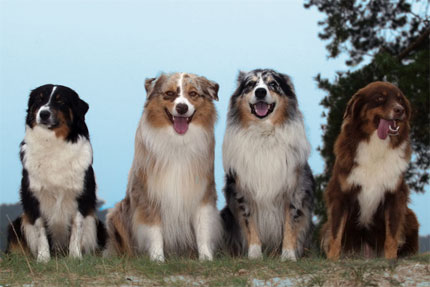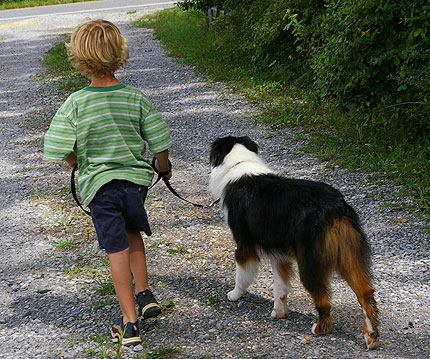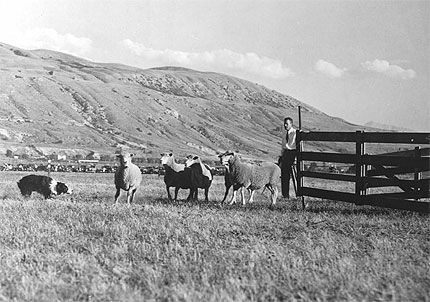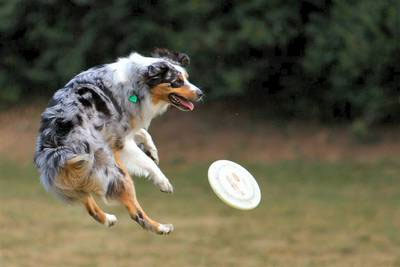|
More on Australian Shepherds
The Australian Shepherd is a working dog that was developed in the United States in the 19th century. The dog, commonly
known as an Aussie, is popular in its native California and is growing in popularity in countries across the world. Contrary
to its name, the breed did not originate in Australia. Like many working breeds, the Aussie has considerable energy and drive
and usually needs a job to do. It often excels at dog sports such as frisbee and dog agility.
Aussie Appearance

The four most common colorings of Aussies are blue merle, red merle, black tri, and red tri. Aussies can come in many other
colorings as well, such as solid red, or solid black; all can occur with or without white markings, tan (called 'copper') points,
or both. Dogs with tan and white along with the primary color are called tricolor. Dogs with white or copper only along with the
primary color are called bicolor. Too much white on any Aussie is a serious flaw, because it is frequently accompanied by deafness
and/or blindness, which can occur when two merles are bred together (the double merle) or when pigmentation doesn't cover the ears
or eyes on any other breeding.
There is also great variety in the Aussie's eye color. An early nickname for the breed was 'ghost-eye dog'. Aussie eyes may be
green, hazel, amber, brown, or blue; they may have two different colored eyes, or even have bicolored or 'split eyes' (for example,
a half-brown, half-blue eye), which appear to be linked to the merle coloration. Any combination of eye color is acceptable in the
breed standard, so long as the eyes are healthy. In general, however, black Aussies tend to have brown eyes, while red Aussies tend
to have amber eyes.
The breed's general appearance also varies greatly depending on the particular line's emphasis. As with many working breeds that
are also shown in the ring, there are differences of opinion among breeders over what makes an ideal Australian Shepherd.
Reflecting the great variation that still exists in the breed, an Aussie can stand between 18 and 23 inches (46 to 58 cm) at the
withers and weigh between 35 and 70 pounds (16 to 32 kg). For show dogs, females should fall in the lower heights and males in the
higher ranges.
A hallmark of the breed is a short bobbed or docked tail in countries where docking is permitted. Some Aussies are born with
naturally short bobbed tails, others with full long tails, and others with natural partial bobs, where the tail is midlength and
appears stubby. Most breeders dock the tails when the puppies are born.
Aussie Temperment

The Australian Shepherd has a unique situation with regard to its temperament. Because the breed is split, there are two distinct types
of personality to look out for depending on the lines, as well as many shades within these two types.
Generally the breed is an energetic dog that requires exercise and enjoys working, whether it is learning and practicing tricks, competing
in dog agility, or any other physically and mentally involving activity. Many need to run, full out, regularly. It is usually a sweet and
affectionate dog who is faithful to its owners and may be good with children, although its overwhelming instinct to work may subvert its ability
to function as a family dog.
Dogs with strong working instinct may show more reserved, guarding behaviors along with a tendency to chasing or nipping at running children
or strangers if not properly trained. Its protective instinct and behaviors can be frightening to children, strangers, and small animals. Those
bred for a more family-oriented temperament are more friendly and affectionate with strangers and generally more reliable around children. Because
the breed was developed to serve on the ranch, a job which includes being protective of its property, it can be sometimes annoying with its
inclination to bark warnings about neighborhood activity, but it is not generally an obsessively barking dog.
Aussies may often greet you with a smile, snorting, and 'butt wagging'. The Aussie has its own unique smile by showing all their teeth, and
often by snorting in a fashion that resembles sneezing. Since most Aussies don't have tails, they wag their butt instead. It is intelligent,
learns quickly, and loves to play. This means that a bored, neglected, unexercised Aussie will invent its own games, activities, and jobs,
which to a busy owner might appear to be hyperactivity in the house around fragile furnishings or involve the destruction of yard and property.
The Australian Shepherd has a reputation as a highly intelligent and versatile stock dog with a range in working styles. While improperly
trained or frustrated Aussies may exhibit excessive running and barking, a good working Aussie is quick, thoughtful, and easy with its stock.
The ability for the breed to adapt to the situation and think for itself makes it an excellent all-around worker. For this reason the Aussie
is often chosen to work unusual livestock such as ducks (e.g., Indian Runners), geese and commercially raised rabbits.
History

The Australian Shepherd's history is vague, as is the origin of its misleading name. The majority of the breed's antecedents most likely originated
in the Basque region near the Pyrenees Mountains between Spain and France.
Early European settlers took many of their herding dogs with them as they emigrated to the eastern United States in the 19th century. Breeds
included some that are now extinct or that have merged into other breeds. These probably included the English Shepherd, Dorset Blue Shag, Cumberland
Sheepdog, Scottish Collie, Glenwherry Collie, and Bouvier des Flandres, as well as dogs from Germany and Spain. For many centuries, shepherds had more
interest in dogs who performed well when helping to manage flocks of sheep than they had in the specific appearance of the dogs. As a result, over time,
shepherds interbred dogs that they believed would produce better workers for the given climate and landscape. Terrain and weather conditions in the
eastern U.S. were similar to that of Europe, however, so the existing imported breeds and their offspring worked well there.
In the western states, conditions were quite different. In the primarily arid and semiarid areas inhabited sparsely by early Spanish settlers,
temperatures reached extremes of hot and cold, and fields varied in altitude from sea level into the higher, rougher Sierra Nevada and similar mountain
ranges. A few Spanish and Basque shepherds, their flocks, and their herding dogs came to California with the Spanish missionaries and other settlers
in the 18th and early 19th centuries.
With the 1849 California gold rush, a massive migration occurred from the east coast to the west coast, and along with the people came flocks of
sheep and the eastern herding dogs. But it was just as effective to bring sheep in by ship, and in they came, including flocks from Latin America and
other regions. Shepherds came along with the flocks and also independently, from Latin America, Europe, and Australia, along with their own herding
breeds.
Dogs from Australia had already begun to be selected and bred for climates and terrains that were often similar to California.
As shepherds worked to develop dogs who could handle stock in harsh storms, high arid heat, and chilling cold, and who could think on their own in
challenging terrain, reacting instantly to the movement of sheep and to their handlers' commands, the type that became the Australian Shepherd was born.
The name remains somewhat of a mystery, however; the largest influx of shepherds from Australia arrived in the early 20th century, well after the
breed had been established as a distinct type. It is possible that many of the imported Australian herding dogs had merle coloring, which was also
common in the American Australian Shepherd breed, and so all merle herding dogs were simply referred to as Australian. This remains conjecture.
Recent History

Selective breeding for many generations focused on aspects of the dog that enabled it to function as an effective stockdog in the American west. It had
to handle severe weather; have plenty of speed, athleticism, energy, and endurance; and be intelligent, flexible, and independent while remaining obedient.
The Australian Shepherd remained more of a type than a breed until the 1950s, when they became popular as performing dogs in rodeos. Their stunts and skills
earned them places in several Disney films, including Run Appaloosa Run and Stub: The Greatest Cowdog in the West.
The Australian Shepherd Club of America (ASCA) was founded in 1957 to promote the breed, and the National Stock Dog Registry became its official breed
registry the same year, which it continued until ASCA took over in the 1970s. In the late 1970s, ASCA created a breed standard, which described exactly how
a dog should look and be constructed (its conformation). This was the first step in becoming a breed rather than a type.
In the United States, the AKC is the primary breed registry for purebred dogs. However, many Aussie breeders felt that AKC put too much emphasis on
conformation and not enough on performance, so ASCA declined to join the AKC. Those breeders who felt that AKC membership had its advantages split off
from ASCA to form their own Australian Shepherd club, the United States Australian Shepherd Association, created their own breed standard, and joined
the AKC in 1993. The decision about affiliation with the AKC remains controversial, as it does with many performance breeds.
These dogs excel at many dog sports, especially herding, dog agility, frisbee, and flyball.
|